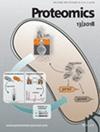Targeted Quantitation of Phosphotyrosine-Containing Proteins in T-Cell Receptor Signaling Using a SureQuant-Based Mass Spectrometry Approach
Abstract
T-cell receptor (TCR) signaling plays a crucial role in various biological processes and is usually studied using global mass spectrometry-based phosphoproteomic studies. Despite advancements in targeted mass spectrometry-based assays for protein quantification, their application in studying signaling processes, for example, reproducible measurements of post-translational modifications (PTMs) such as phosphorylation, remains limited. Tyrosine phosphorylation is critical for many signaling pathways but presents challenges due to the low abundance of phosphotyrosine-containing peptides. Conventional untargeted methods often encounter data gaps when analyzing large sample sets, particularly for low-abundance peptides. To address this issue, a targeted proteomics method called “SureQuant” was employed, which relies on triggered data acquisition with heavy isotope-labeled peptides. This method has been shown to provide sensitive and reproducible quantification of low-abundance peptides. Here we describe the development of a SureQuant-based method to quantify phosphotyrosine peptides that are involved in the TCR signaling pathway. To monitor the change in phosphotyrosine signals upon activation, the T-cells were stimulated with anti-CD3/CD28 antibodies. We successfully quantified changes in important phosphotyrosine peptides in primary T-cells upon stimulation with anti-CD3/CD28 antibodies. This study showcases the ability of the SureQuant approach to accurately quantify low-abundance phosphotyrosine peptides, highlighting its broader potential to study a diverse set of PTMs in physiological or clinical settings.
Summary
-
T-cell receptor (TCR) signaling plays a fundamental role in immune responses, regulating T-cell activation, differentiation, and function. While tyrosine phosphorylation is a key regulatory mechanism in this pathway, the low abundance of phosphotyrosine peptides presents a major challenge for their detection and quantification in complex biological samples. By employing the SureQuant targeted mass spectrometry approach, we achieved highly sensitive and reproducible quantification of key phosphotyrosine sites involved in T-cell activation.
-
This study provides a systematic view of TCR signaling dynamics, revealing distinct phosphorylation patterns across different activation timepoints. Our findings demonstrate the effectiveness of SureQuant in quantifying low-abundance, post-translationally modified peptides, offering a valuable tool for studying signaling pathways with greater precision.
-
Additionally, this methodological framework can be extended to investigate other signaling networks, immune cell functions, and disease-associated phosphotyrosine modifications.




 求助内容:
求助内容: 应助结果提醒方式:
应助结果提醒方式:


